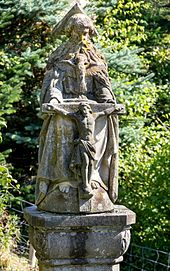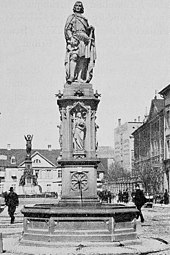Josef Alois Knittel
Josef Alois Knittel (born April 20, 1814 in Oberbach im Lechtal , Tyrol ; † December 23, 1875 in Freiburg im Breisgau ) was a sculptor who, after completing his studies, mainly worked in Freiburg im Breisgau, which at that time belonged to the Grand Duchy of Baden .
Life
On his mother's side he was the nephew of the painter Joseph Anton Koch , on his father's side the uncle of Anna Stainer-Knittel (the " Geierwally ") and the father of the sculptors Gustav Adolf (1852-1909) and Berthold Knittel (1853-1918).
The son of a master tailor was discovered by his drawing teacher Anton Falger and placed in Munich. There he began to study at the art academy on November 9, 1835 , which led him to study with Ludwig Schwanthaler and Peter von Cornelius . After completing his studies on January 22, 1838, he went to Freiburg in 1847 and settled there. In 1848 he married Thekla Geiges, daughter of the district auditor Anton Geiges. In addition, she was the sister of the town planner Sigmund Geiges , with whom he associated in the artist society Ponte Molle . In 1867 Anna Stainer-Knittel, Knittel's niece, visited him in Freiburg to win him over as a supporter for her planned wedding, which her father wanted to prevent.
After his own son Gustav died at the age of six months, Knittel became the godfather of his nephew, who later became the glass painter Fritz Geiges . The sculptor Joseph von Kopf learned from Knittel and Wilhelm Dürr in Freiburg from 1850 , before setting off on foot in the direction of Rome in 1852. Kopf executed some works by Knittel that he had previously modeled.
Knittel was no longer able to fulfill the order of Mayor Carl Röttinger to create four statues of the seasons for the facilities around the Freiburg train station by April 1876 : he died of heart failure on December 22 or 23, 1875 . After Knittel's death, his widow and sons Gustav Adolf and Berthold continued to run the studio.
plant
During his time in Munich, Knittel was mainly inspired by the religiously motivated neo-Gothic style of the former professor Konrad Eberhard . Although he was already retired at the time, he had left his mark on the academy. Knittel mainly worked with sandstone .
One of his works that is still known today is the monument to Berthold Schwarz on Freiburg's town hall square. In World War II destroyed a statue of the Duke Albrecht VI. as well as the relief of the good Samaritan at the mother house of the good sister in the Zähringerstrasse. The secondary school, the gable of which was adorned with the colossal figures of theory and technology by Knittel, survived the bombing of November 27, 1944 , but had to make way for the new Freiburg University Library in the post-war period . In addition, Knittel created over 100 tombs in the Old Freiburg Cemetery , starting with the one for Karl Joseph Beck (1794–1838) from 1845. This was followed, for example:
- Ferdinand Geminian Wanker (1758–1824), Archbishop-designate
- Johann Leonhard Hug (1788–1846), professor of oriental languages and exegesis of the Old and New Testaments
- Joseph Anselm Feuerbach (1798–1851), archaeologist
- Amalia Koslowska († 1852)
- Johann Michael Meißburger (1782-1854), cathedral curator
- Joseph von Auffenberg (1798–1857), playwright and poet
- Franz Xaver Stegmann (1800–1858), beer brewer
- Pauline Schleip (1824–1862)
- Johann Baptist von Hirscher (1788–1865), professor of theology and dean of the cathedral
- Marie de Colombi (1782–1872), countess
- Maria Antonia Gertrudis de Colombi (1809–1863), daughter of Marie
- Christine de Zea Bermudez y Colombi (1841–1866), daughter of Maria
- Madeleine Barone de Reinach (1765–1845)
In 1856, Knittel created a table memorial with a figure of a knight. This was probably intended as a wedding present for Grand Duke Friedrich I and Princess Luise of Prussia on September 20, 1856. The figure is now in the Museum of City History (Freiburg im Breisgau) .
In 1869 Knittel was asked for an offer for a new cross for the Freiburger Unterlinden-Platz. The city couldn't come to an agreement with him. It took until 1890 for a new group of figures to be created by the Freiburg sculptor Julius Seitz .
In the competition for the design and execution of the Victory Monument in 1872 he took part, but could not prevail against Karl Friedrich Moest . Knittel's son Gustav Adolf was later involved in the execution of the soldiers as a master student at Moest. In 1872 he made a bust of General August von Werder out of white marble for a Werder memorial in Werder-Straße at Villa Platenius .

There are also works by Knittel outside of Freiburg: in the Tyrolean State Museum in Innsbruck there is (a) a plaster relief or a wooden sculpture of Christ heals the possessed , while in the monastery chapel in Bruchsal there was a wooden sculpture created by Knittel in 1860. At the exit of Stegen there is a Trinity column from 1865. In nearby St. Peter there are also two mercy seats from the period between 1867 and 1872. For the hospital church of Breisach am Rhein he created the tomb of Father Pantaleon Rosmann († 4. March 1853) as well as that for the new Philipsburg priest August Rombach (November 9, 1843 in Lenzkirch; † February 18, 1870 in Philippsburg). The Strasbourg citadel received a victory column from him. In Offenburg there is a larger than life statue of Christ, another in Freiburg was destroyed in the war.
Awards
Knittel received two medals of merit: the gold medal for art and science from Grand Duke Friedrich I and another from Emperor Franz Joseph I for his Albrechtsbrunnen.
literature
- Alfred Biehler: The grandfather: sculptor Josef Alois Knittel . In: Heinz Spath: sculptor Hugo Knittel , approx. 1956.
- Eva Boehm: The work of the sculptor Alois Knittel - Possibilities of thematization in the classroom of the secondary school , scientific thesis at the Pedagogical University Freiburg, 1998, PDF 46.6 MB online
- Michael Klant: The Knittel family of artists . In: Sculpture in Freiburg. 19th century art in public spaces. tape 2 . Modo, Freiburg im Breisgau 2000, ISBN 3-922675-77-8 , p. 173-180 .
Web links
Individual evidence
- ↑ a b c estate (PDF; 13 kB) in the Freiburg city archive (accessed December 3, 2012).
- ↑ according to other sources, the father was a court farmer and gunsmith, cf. also Klant p. 207, footnote 1.
- ^ Matriculation Academy of Fine Arts Munich: 02342 Aloys Knittel (accessed March 20, 2010).
- ↑ a b c Rosemarie Beck, Roland Meinig: Brunnen in Freiburg , Rombach, Freiburg im Breisgau 1991, ISBN 3-7930-0550-X , p. 43f.
- ↑ Edelgard Spaude: Wayward Women in Baden , Rombach, Freiburg 1999, ISBN 3-7930-0890-8 , p 49 f.
- ^ Michael Klant: The artist family Knittel . In: Sculpture in Freiburg. 19th century art in public spaces. tape 2 . Modo, Freiburg im Breisgau 2000, ISBN 3-922675-77-8 , p. 174 .
- ↑ Landesarchiv Baden-Württemberg, Dept. Hauptstaatsarchiv Stuttgart: Holdings Q 2/14: Nachlass Josef Kopf (1827–1903) - preliminary remarks (accessed March 20, 2010).
- ↑ C1 Monuments (PDF; 13 kB) in the Freiburg City Archives (accessed December 3, 2012.)
- ↑ It should be noted here that, despite better knowledge, Alois Knittel apparently backdated the year of invention of black powder to 1853 instead of 1854, like this: Ute Scherb: We get the monuments we deserve. Freiburg Monuments in the 19th and 20th Centuries , Freiburg 2005, ISBN 3-923272-31-6 , p. 44f.
- ↑ Mother House of the Merciful Sisters on alt-freiburg.de (accessed March 21, 2010).
- ↑ Rotteck-Gymnasium: School history (accessed March 21, 2010)
- ^ Leonard Korth: The care of the fine arts in the present . In: Baden Architects and Engineers Association, Upper Rhine District (Ed.): Freiburg im Breisgau. The city and its buildings . HM Poppen & Sohn, Freiburg im Breisgau 1898, p. 604 ( Scan - Wikisource ).
- ↑ a b c d Alfred Biehler: The grandfather: sculptor Josef Alois Knittel in: Heinz Spath: sculptor Hugo Knittel , approx. 1956.
- ^ Hermann Mayer: Unterlinden in Freiburg. In: Schau-ins-Land 61 (1934), pp. 78–84; here p. 80f.
- ↑ Ute Scherb: We get the monuments we deserve. Freiburg monuments in the 19th and 20th centuries . P. 70f. Freiburg 2005, ISBN 978-3-923272-31-0
- ↑ cf. Illustration of the monument in Freiburg im Breisgau. The city and its buildings. Freiburg 1898 , p. 497 .
- ^ Franz Xaver Kraus : Die Kunstdenkmäler des Großherzogthums Baden , Volume 6: Kreis Freiburg , Jacob Christian Benjamin Mohr (Paul Siebeck), Tübingen and Leipzig 1904, p. 72 .
- ↑ City of Philippsburg: Painful Madonna ( Memento of the original from March 4, 2016 in the Internet Archive ) Info: The archive link was inserted automatically and has not yet been checked. Please check the original and archive link according to the instructions and then remove this notice.
| personal data | |
|---|---|
| SURNAME | Knittel, Josef Alois |
| BRIEF DESCRIPTION | German sculptor |
| DATE OF BIRTH | April 20, 1814 |
| PLACE OF BIRTH | Oberbach in the Lechtal |
| DATE OF DEATH | December 23, 1875 |
| Place of death | Freiburg in Breisgau |


